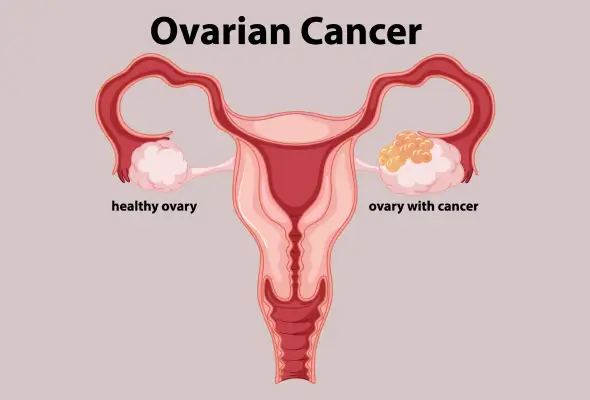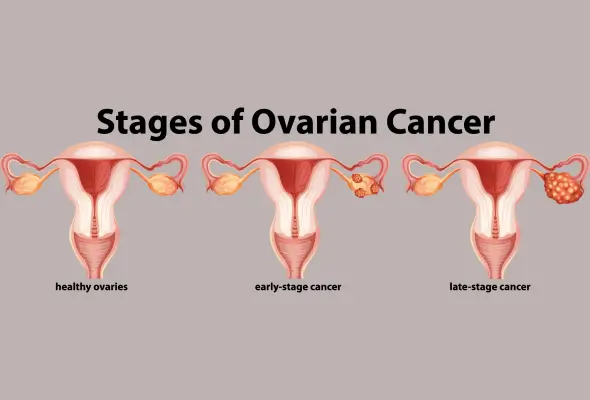-
Doctors
-
Specialities & Treatments
Centre of Excellence
Specialties
Treatments and Procedures
Hospitals & Directions HyderabadCARE Hospitals, Banjara Hills CARE Outpatient Centre, Banjara Hills CARE Hospitals, HITEC City CARE Hospitals, Nampally Gurunanak CARE Hospitals, Musheerabad CARE Hospitals Outpatient Centre, HITEC City CARE Hospitals, Malakpet
HyderabadCARE Hospitals, Banjara Hills CARE Outpatient Centre, Banjara Hills CARE Hospitals, HITEC City CARE Hospitals, Nampally Gurunanak CARE Hospitals, Musheerabad CARE Hospitals Outpatient Centre, HITEC City CARE Hospitals, Malakpet Raipur
Raipur
 Bhubaneswar
Bhubaneswar Visakhapatnam
Visakhapatnam
 Nagpur
Nagpur
 Indore
Indore
 Chh. Sambhajinagar
Chh. SambhajinagarClinics & Medical Centers
Book an AppointmentContact Us
Online Lab Reports
Book an Appointment
Consult Super-Specialist Doctors at CARE Hospitals

Ovarian Cancer
Symptom, Causes, Diagnosis and Treatment
Ovarian Cancer
Ovarian cancer is an oncological medical condition in females. It generally begins in the ovaries, which are small organs of the female reproductive system where eggs are formed. It can be difficult to detect early because symptoms often do not appear until later stages.
Let's go through an overview of ovarian cancer, including its causes, symptoms, stages, diagnosis, treatment, and prevention.

What is Ovarian Cancer?
The ovaries are small, walnut-sized organs that are a part of the female reproductive system. These ovaries, producing eggs during a woman's reproductive years, can undergo cellular anomaly, causing abnormal cell growth. Ovarian cancer starts when abnormal cells in the ovaries or fallopian tubes grow out of control. Ovarian cancer is more prevalent and causes more deaths compared to other cancers of the female reproductive system.
Who Gets Ovarian Cancer?
Ovarian cancer mainly affects women and people assigned female at birth (AFAB). It is slightly more common among Native American and white populations compared to Black, Hispanic or Asian populations.
People of Ashkenazi Jewish descent have a higher risk of BRCA gene mutations, increasing their chance of ovarian and breast cancer. Ovarian cancer accounts for 3.34% of cancer deaths in India among women dying from cancers.
Symptoms of Ovarian Cancer
Ovarian cancer is challenging to detect early since symptoms often don't appear until the later stages. Some signs to watch for include:
- Pelvic or belly pain, bloating, or feeling overly full - This can indicate a growing tumor.
- Appetite and eating changes - Losing your appetite or feeling full could signal ovarian cancer.
- Vaginal bleeding - Abnormal bleeding outside your regular cycle or after menopause needs evaluation.
- Bowel habit changes - Constipation or diarrhoea that persists may reflect disease spread.
- Increased belly size - The abdomen may swell due to fluid buildup from cancer.
- Peeing more frequently - Needing to urinate more often could result from growing tumors pressing on the bladder.
If any of these ovarian cancer red flags develop, it's crucial to see your healthcare provider right away for evaluation. Diagnosing the cancer early is key to more effective treatment and survival. Don't ignore worrisome symptoms - schedule an appointment promptly for diagnosis and management.
Causes Of Ovarian Cancer
While the precise cause of ovarian cancer is not yet known, certain factors can raise a woman's risk:
- Age over 60 - Risk goes up as women get older, with most cases occurring after menopause.
- Obesity - Excess weight is linked to increased ovarian cancer risk.
- Family history - Having close relatives who had ovarian cancer or mutations like BRCA1/2 genes can predispose you.
- Pregnancy history - Never being pregnant or older age at first pregnancy seems to increase risk.
- Endometriosis - This condition where tissue grows outside the uterus is associated with higher ovarian cancer odds.
The risk of developing ovarian cancer also rises as women get older. Key pointers to be aware of are:
- Know your family history and consider genetic testing if you are at high risk.
- Ensure you have a healthy diet to maintain your weight while also paying attention to exercising daily.
- Seek treatment for endometriosis if present.
- Discuss your reproductive history with your doctor.
Monitoring for symptoms and screening at older ages are essential for early detection.

Ovarian Cancer Stages
Ovarian cancer is categorized into four stages to help guide treatment and predict prognosis. Stage 1 represents the earliest stage with the best outlook, while Stage 4 means the cancer has advanced to other parts of the body:
- Stage 1: In Stage 1, the cancerous tumor is confined to one or both ovaries and fallopian tubes. This stage has three subcategories. Stage 1A means the growth is limited to just one ovary. Stage 1B indicates it has spread to both ovaries and tubes. Stage 1C denotes cancer found on the outer surface of the ovaries or in fluid around the ovaries.
- Stage 2: Stage 2 ovarian cancer has moved beyond the ovaries and tubes but is still limited to the pelvic region. Subtypes include Stage 2A, where cancer has spread to the uterus and Stage 2B, where it has grown into other pelvic tissues.
- Stage 3: In Stage 3, the tumor has spread to the abdomen and lymph nodes, with three substages. Stage 3A cancer is found microscopically in the lining of the abdomen or pelvic lymph nodes. In 3B, deposits are less than 2 centimeters. Stage 3C tumors are larger and may be in the lymph nodes.
- Stage 4: Stage 4 means the cancer has metastasized to more distant organs like the liver, lungs or spleen. Stage 4A is in the fluid near the lungs, while 4B has spread to lymph nodes and organs in the upper abdomen.
Diagnosis of Ovarian Cancer
There is no effective ovarian cancer screening test yet. Pelvic exams, imaging tests, blood tests for CA-125 levels, and surgical evaluation can be used to diagnose it.
If ovarian cancer is suspected, the healthcare provider might ask about symptoms and do a pelvic exam to check for abnormalities.
Additional tests may include:
- Imaging like pelvic ultrasound, MRI, CT scan, or PET scan
- Blood tests to look for high CA-125 levels
- Surgery to remove concerning growths and confirm diagnosis
Treatment Approaches for Ovarian Cancer
The goal is to remove as much cancer as possible. Common treatments include:
- Surgery to remove ovaries, reproductive organs, and affected areas
- Chemotherapy drugs before or after surgery
- Targeted therapy drugs that specifically attack cancer cells
- Hormone therapy to slow cancer growth
- Radiation therapy, if required
After treatment, regular appointments monitor for recurrence.
When to See A Doctor?
Don't ignore persistent abdominal symptoms. See your doctor if you notice severe or frequent:
- bloating,
- pelvic pain,
- feeling full fast,
- appetite changes,
- abdominal swelling,
- back pain,
- constipation,
- frequent urination
- abnormal bleeding
Ovarian cancer warning signs often appear later, so getting checked out promptly gives the best chance for early detection and successful treatment:
- Schedule an appointment right away if symptoms are frequent or worsening
- Inform your doctor about any family history of ovarian cancer
Prevention of Ovarian Cancer
Though ovarian cancer can't be fully prevented, certain steps may lower risk. Knowing your family history helps you understand if you're at higher risk. For those with BRCA mutations, preventive surgery to remove the ovaries and fallopian tubes before cancer develops may be recommended. Other tips include:
- maintaining a healthy weight,
- exercising,
- avoiding hormone therapy after menopause,
- having any endometriosis or pelvic issues treated.
Conclusion
An ovarian cancer diagnosis for any female can be frightening and emotional at the same time, even for the family members. However, healthcare providers can offer resources, support groups, and guidance. Connecting with others facing the same diagnosis may help process difficult feelings. Be aware of any persistent symptoms and share them with your doctor. Treatment and regular monitoring can help manage ovarian cancer and offer you a good quality of life.
FAQs
1. Is ovarian cancer curable?
Ans. Yes, the majority of the patients at the initial stages are known to be cured of Ovarian Cancer.
2. What are the early symptoms and signs of ovarian cancer?
Ans. Bloating, pelvic pain, feeling full quickly, loss of appetite, fatigue, back pain, constipation, frequent urination.
3. Kothaguda
Ans. Yes, it is. It’s known to cause more deaths as compared to other female reproductive cancers. The lifetime risk of dying is around 1 in 108.
4. How painful is ovarian cancer?
Ans. The growing tumour can cause swelling and pain in the belly, pelvis, lungs, and other areas.

Still Have a Question?



